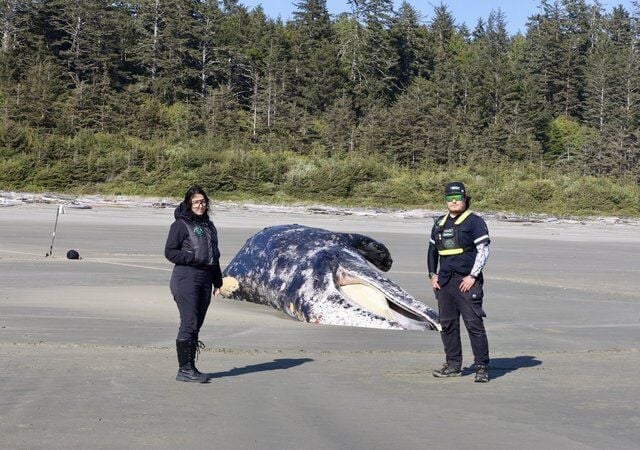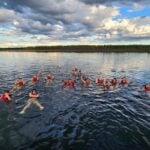Nora O’Malley, Local Journalism Initiative Reporter, Ha-Shilth-Sa
Long Beach, BC — Tla-o-qui-aht Tribal Parks Guardian Gisele Maria Martin spotted the whale floating out in rough seas in front of the Esowista Peninsula on Monday, and by Wednesday, the magnificent creature had found its final resting place just south of Lovekin Rock on Long Beach in the Pacific Rim National Park Reserve.
“The first thing we did was a ceremony. We did a chant for the whale,” said Martin.
“When I first arrived, people were quite close and poking the whale. We just don’t want to see the whale getting walked on for selfies.”
Gisele Maria Martin, Tla-o-qui-aht Tribal Parks Guardian
Then the Guardians secured a rope around the tail of the deceased juvenile gray whale to save him from the rising tide, and with the help of Parks Canada, they drew lines in the sand to create a perimeter around the body.
“When I first arrived, people were quite close and poking the whale. We just don’t want to see the whale getting walked on for selfies,” she said.
In Nuu-chah-nulth culture, whales are represented in a lot of stories and have brought wealth to nations, says Martin. They also carry a strong connection to the supernatural.
“Seeing it up close made me think of the amazing strength and endurance that the whale hunters had,” she said.
For many curious onlookers, the sight of the dead whale brought on a flood of emotions.
“There was one woman visiting from Alberta…She was in tears about it,” said Martin.
DFO to conduct full necropsy
Ph.D. biologist and Tofino resident Jim Darling has been researching whales since the 1970s. He told the Ha-Shilth-Sa that Fisheries and Oceans Canada (DFO) will perform a full necropsy of the gray whale to determine the cause of death.
“To have a whale wash in dead at this time of year is not really unusual at all. It happens most years,” said Darling.
Gray whales spend their summers feeding in the northern latitudes, right up into the Arctic and even into the Beaufort Sea, explained Darling. They feed all summer, and then they migrate south to Mexico, where they feed “little to none.”
“This is when they are most vulnerable. They have been living off fat reserves from last summer’s feeding,” he said.
“I think the consensus is amongst most researchers is that the problem is in the Arctic where the ecosystem has changed quite dramatically.”
Jim Darling, Ph.D. biologist and Tofino resident
“However, to complicate that, though, the last couple of years and continuing this year for sure, there is something else going on for sure,” Darling continues.
It has been widely reported that over 70 whales have died this year along Mexico’s Baja California coast, where wintering females give birth and nurse their calves.
“That’s shocking. Those numbers are really high. Everyone is concerned,” said Darling. “I think the consensus amongst most researchers is that the problem is in the Arctic, where the ecosystem has changed quite dramatically. The feeling is that these gray whales just aren’t getting the food reserves they need to make it through the migration and the winter-feeding season.”
There are roughly 200 local gray whales that live off the coast of Vancouver Island and around 15,000 grays that do the migration route, according to Darling. He said the migrating herd is overall “really stressed,” while the local herd seems “stable”.
He said the results of the necropsy will determine whether the whale died from an empty stomach, which would indicate malnourishment.
“They store their fat reserves in their blubber. They can measure the thickness of that, and it gives an indication of the health of the whale,” Darling said, noting that the necropsy will also examine the whale’s organs, blood and skin.
maaʔak means ‘take a big bite’
In Tla-o-qui-aht language, the word for gray whale is maaʔak, which translates to ‘take a big bite’.
Martin says Tribal Parks Guardians is looking at taking some of the whale blubber, whale bones to carve traditional tools and some of the baleen for traditional regalia.
Tom Campbell, of Ahousaht First Nation, brought his grandkids to see the deceased whale on May 7.
“We had one wash-up in Ahousaht some years back. I got to taste it because they started cutting it up. It was chewy. A little bit hard to chew. Years ago, they used to put the blubber on a big fire to make oil, and they had some pretty sharp tools to cut it up,” Campbell shared.
While commercial whaling decimated the species, putting an end to traditional whale hunting for Nuu-chah-nulth, the Makah Tribe located in Washington State at Neah Bay recently submitted an application for a permit to hunt a limited number of North Pacific gray whales for ceremonial and subsistence purposes in the summer of 2025 and 2027.
Public comments on the Makah Tribe’s application closed on May 5, and a decision is pending.
A necropsy is now underway, according to DFO.




